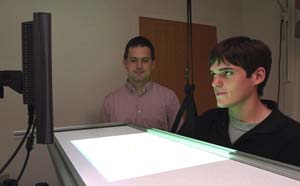Practice makes perfect when people learn behaviors, from baseball pitching to chess playing to public speaking. And now, WUSTL biomedical engineers have identified how people use individual experiences to improve performance.
Kurt A. Thoroughman, Ph.D., assistant professor of biomedical engineering, and Jordan A. Taylor, a doctoral student in biomedical engineering, had a dozen volunteers play a video game that involved a robotic arm. Thoroughman and Taylor found that the subjects learned different levels of the game in just 20 minutes of training over different environmental difficulties.

The video game involved the human subjects controlling a robotic arm and trying to use it to hit a target. But as the subjects learned the game, the robotic arm began to push the human arm. The robot force changed directions at the same rate, twice as fast, or four times as fast as the change in direction of human movement. This exposed the subjects to environments of increasing complexity.
Subjects learned all three environments and learned the low and medium complexity environments equally well. They learned the high complexity environment, too, though not as well as the other two.
Thoroughman and Taylor could also detect how individual movements trained people to make the next movement better.
Surprisingly, people could very quickly change the way errors in one movement induced a learned response in the next movement. Specifically, subjects lessened their movement-by-movement adaptation and narrowed the spatial extent of generalization to match the environmental complexity, showing that people can rapidly reshape the transformation of sense into motor prediction to best learn a new movement task.
“We’ve demonstrated that the richness of motor training determines not only what we learn but how we learn,” Thoroughman said. “What we cared about most was not only what people learned but how they learned from trial to trial, movement to movement.
“The big picture is that in a single sitting, people changed their expectations of the complexity of the world, in that a single movement’s experience could be generalized very broadly or else generalized very narrowly.
“We’ve shown for the first time that the learning process itself is flexible. People can figure out that in this particular environment: ‘I need to change the way I learn, movement to movement.'”
The researchers published their findings in a recent issue of Nature Neuroscience.
Ultimately, these findings can help researchers devise better diagnostic tools for people with neurological disorders and could lead to better neuro-prosthetic devices.
Thoroughman and Taylor went on to model the human subjects’ adaptation using a neural network. They found that, to mimic human behavior, the modeled neuronal tuning of movement space needed to narrow and reduce gain with increased environmental complexity.
According to Thoroughman, prominent theories of neural computation have hypothesized that neuronal tuning of space, which determines generalization, should remained fixed during learning so that a combination of neuronal outputs can underlie adaptation simply and flexibly. Thoroughman showed that this tuning of space is instead flexible.
“We challenged those well-known theories with evidence that the neuronal tuning of movement space changed within minutes of training our subjects,” Thoroughman said.
“The overall research goal for this part of my lab is to characterize as carefully as possible how people abstract information from single movements to make the very next movement better. I want to understand more about how human motor control goes right before I understand how to help people when it goes wrong.”